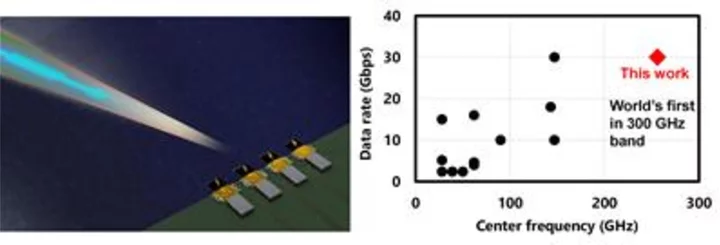TOKYO--(BUSINESS WIRE)--Jul 18, 2023--
NTT Corporation (President and CEO: Akira Shimada, "NTT") and researchers with the Tokyo Institute of Technology (President: Kazuya Masu; “Tokyo Tech”) announced the successful demonstration of a phased-array transmitter module to enable instantaneous ultra-high capacity data transmission to mobile receivers. The researchers succeeded in achieving the world’s first wireless data transmission via beamforming in the 300 GHz band, which is expected to be utilized in the realization of sixth-generation (6G) communications.
This press release features multimedia. View the full release here: https://www.businesswire.com/news/home/20230718210666/en/
Figure 1: (Left) Image of beamforming using phased-array wireless device. (Right) Comparison of previously reported transmission with beamforming wireless devices and this achievement. (Graphic: Business Wire)
Researchers presented details of the technology at the 2023 IEEE MTT-S International Microwave Symposium (IMS2023), held in San Diego, Calif. in June 2023.
Research Background
In 6G wireless communications systems, ultra-high-speed wireless communications are expected to be achieved by utilizing the 300 GHz band. This band has the advantage of being able to use a wide frequency range. On the other hand, it faces the problem of large path loss during signal propagation through space. Beamforming technology is being studied to overcome this problem.
Beamforming concentrates and directs radio energy toward the receiving device. In 5G wireless systems that use radio waves in the 28 GHz and 39 GHz bands, beamforming has been realized with CMOS 1 integrated circuits (IC). On the other hand, CMOS-IC alone lacks sufficient output power in the 300 GHz band 2. Combining CMOS-IC with III-V compound IC 3, capable of high-output power, is therefore being attempted around the world to achieve beamforming in the 300 GHz band. However, because high-output power is prevented by the large energy loss occurring inside the III-V compound IC and in the connection between the III-V compound IC and the CMOS-IC, high-speed wireless data transmission by beamforming has not been achieved until now.
Research Results
NTT has developed indium phosphide integrated circuit (InP-IC) chips that integrate NTT’s proprietary high-output power amplifier circuit and antenna circuit. This achievement is made possible with NTT’s proprietary indium phosphide-based heterojunction bipolar transistor (InP HBT) 4 technology. Tokyo Tech has succeeded in fabricating a highly scaled CMOS-IC containing frequency conversion and control circuits. NTT and Tokyo Tech have now developed a compact four-element phased-array transmitter module 5 by mounting the aforementioned CMOS-IC and InP-IC on the same printed circuit board. With a steering range of 36 degrees, maximum data rate of 30 Gbps, and communication distance of 50 cm, this transmitter module has succeeded in achieving the world’s first high-speed wireless data transmission in the 300 GHz band using beamforming (Figure 1).
Key Technological Points
In NTT and Tokyo Tech’s achievement, the following two technologies made the beamforming and high-speed wireless data transmission possible.
1. Design of 300 GHz band high-output power amplifier circuit
NTT and Tokyo Tech have designed a power amplifier circuit 6 that achieves high-output power in the 300 GHz band and realized its fabrication by using NTT’s proprietary InP HBT technology. For the power amplifier circuit, high output power is achieved by combining electrical power output from multiple amplifier elements using a low-loss power combiner. The circuit amplifies the signals output from the CMOS-IC and radiates the radio wave to the receiving device from the antenna packaged on the same chip. NTT and Tokyo Tech’s achievement enables the delivery of high-output power to the receiving device, which is needed for high-speed data transmission (Figure 2).
2. High-frequency band low-loss mounting technology
Conventionally, to connect different types of ICs for the 300 GHz band, each IC is mounted on a waveguide module 7, and the modules are connected together. However, this approach has the problem of energy loss when radio waves pass through the waveguides. NTT and Tokyo Tech’s achievement overcomes this problem through flip-chip bonding 8 of the CMOS-IC and the InP-IC and connecting them using metal bumps of several ten micrometers in size. This packaging approach reduces connection loss and achieves high-output power (Figure 3).
Future Research
Short-distance mobile communication devices are expected to be deployed in 6G networks in the future. NTT and Tokyo Tech’s developed technology promises to expand these applications, such as interactive kiosks and femtocells. The developed technology demonstrated one-dimensional beamforming. NTT and Tokyo Tech are working on demonstrating two-dimensional beamforming with a 2D array and extending the communication distance by increasing the number of arrays. NTT and Tokyo Tech are also engaged in the development of receiver modules to meet the needs of 6G applications, and in the practical implementation of wireless communication with transmission capacity ten-fold greater than is available today.
Glossary
- CMOS-IC (Complementary Metal Oxide Semiconductor-Integrated Circuit): Integrated circuit on metal oxide semiconductor. It is used to achieve large-scale functions such as digital control. This type of circuit is often used for large-capacity transmission and reception because of its ability to handle large amounts of signals. Although device scaling has led to higher speeds, the use of compound semiconductors in CMOS-IC is superior in achieving greater speed and output power.
- February 2021 press release: “Pushed to the Limit: A CMOS-based transceiver for beyond 5G applications at 300 GHz,” https://group.ntt/en/newsrelease/2021/02/05/210205c.html
- III-V compound IC: Semiconductor made from two or more elements belonging to group 13 (e.g., gallium Ga, indium In) and group 15 (e.g., nitrogen N, phosphorus P, arsenic As) on the periodic table. A compound semiconductor allows IC devices to handle higher frequencies because it provides greater electron mobility. Note that a III-V compound semiconductor is so-called because the periodic table’s numbered groups to which its elements belong use the numbering scheme prior to the periodic table’s 1990 revision.
- InP HBT: Heterojunction bipolar transistor made from indium phosphide, a III-V semiconductor. This transistor enables excellent high-frequency performance and high breakdown voltage.
- 4-element phased-array transmitter module: Transmitter module with four transmitter elements arranged in parallel. Beamforming is achieved by controlling the phase and intensity of each element’s radio wave output.
- Power amplifier circuit: A circuit that amplifies an input high-frequency signal to the required power and delivers it to the antenna.
- Waveguide module: A module with hollow metal tubes (waveguides) for propagating high-frequency signals.
- Flip-chip bonding: A chip mounting technique in which IC chips are connected to each other or to the circuit board in a “flipped” manner via solder bumps or other bumps.
About NTT
NTT believes in resolving social issues through our business operations by applying technology for good. An innovative spirit has been part of our culture for over 150 years, making breakthroughs that enable a more naturally connected and sustainable world. NTT Research and Development shares insights, innovations and knowledge with NTT operating companies and partners to support new ideas and solutions. Around the world, our research laboratories focus on artificial intelligence, photonic networks, theoretical quantum physics, cryptography, health and medical informatics, smart data platforms and digital twin computing. As a top-five global technology and business solutions provider, our diverse teams deliver services to over 190 countries and regions. We serve over 75% of Fortune Global 100 companies and thousands of other clients and communities worldwide. For more information on NTT, visit https://www.rd.ntt/e/.
NTT and the NTT logo are registered trademarks or trademarks of NIPPON TELEGRAPH AND TELEPHONE CORPORATION and/or its affiliates. All other referenced product names are trademarks of their respective owners. © 2023 NIPPON TELEGRAPH AND TELEPHONE CORPORATION
View source version on businesswire.com:https://www.businesswire.com/news/home/20230718210666/en/
CONTACT: Nick Gibiser
Wireside Communications®
For NTT
+1-804-500-6660
ngibiser@wireside.com
KEYWORD: UNITED STATES JAPAN NORTH AMERICA ASIA PACIFIC CALIFORNIA
INDUSTRY KEYWORD: 5G TELECOMMUNICATIONS NETWORKS HARDWARE DATA MANAGEMENT TECHNOLOGY SEMICONDUCTOR MOBILE/WIRELESS
SOURCE: NTT Corporation
Copyright Business Wire 2023.
PUB: 07/18/2023 08:07 AM/DISC: 07/18/2023 08:05 AM
http://www.businesswire.com/news/home/20230718210666/en









